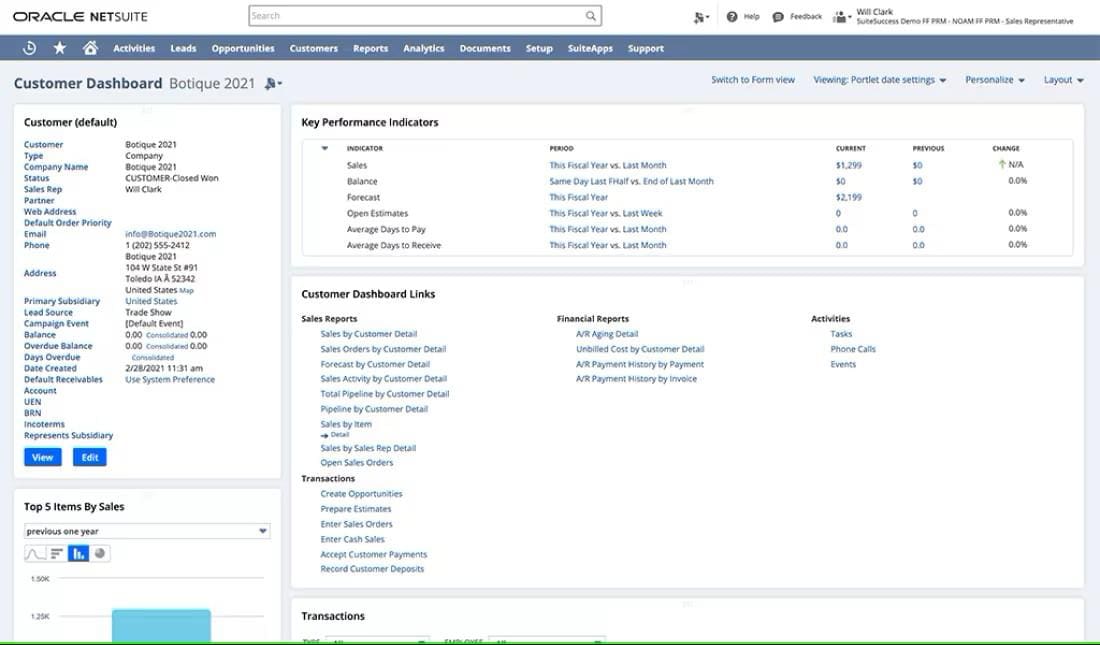Strong customer relationships are critical for any growing business. But as a company expands, it becomes more challenging to keep track of information about clients and prospects. That data is often scattered across financial systems, spreadsheets, emails, and even handwritten notes, making it hard to get a complete picture of critical metrics from churn to customer acquisition cost to lifetime value.
Customer relationship management (CRM) technology is designed to solve that problem. It provides a single source of information that helps salespeople, marketers, and customer service groups drive more revenue, increase productivity, keep track of the health of the business, and, most importantly, build lasting customer relationships.
What Is CRM (Customer Relationship Management)?
Customer relationship management (CRM) technology helps companies get maximum value from client interactions, regardless of which employee is reaching out. A CRM system takes information about your customers and plugs it into a shared platform that helps sales, marketing, and customer service teams conduct business more effectively and, crucially, avoid the dreaded “please repeat your account number, last order, and what you called about yesterday” drill.
CRM systems collect the minutia of customer accounts, such as billing, orders, and service requests, and keep records of “touches” to track sales productivity and ensure a client isn’t being neglected. Automation, data analysis, reporting, and trend identification features help companies learn more about their clientele, including support needs.
Key Takeaways
- CRM systems centralize customer information to help businesses enhance sales, marketing, and customer service processes.
- Businesses use CRM systems to track customer interactions, identify growth opportunities, improve productivity, and deliver faster, more effective results throughout the customer lifecycle.
- Cloud-based CRM solutions have created more accessible and customizable software that companies can integrate with existing systems to address specific needs.
Why Is a CRM System Important for Your Organization?
A well-executed CRM system becomes the foundation for a business’s customer strategy. As companies grow, maintaining strong customer relationships becomes increasingly challenging—sales teams must track and follow up on prospects through complex sales cycles, retain existing customers in competitive markets, and identify expansion opportunities within their existing customer base. CRM systems give businesses a comprehensive way to manage these relationships, minimizing the risk of losing valuable opportunities to more organized competitors.
Businesses can also use their CRM systems to automatically capture and analyze customer interactions, identify trends in customer preferences, spot early warning signs of customer dissatisfaction, and uncover opportunities for upselling or cross-selling. For example, when a customer reaches out with a product issue, companies can turn that potentially negative experience into a loyalty-building moment by providing fast, personalized service through a combination of automated self-help tools and quick visibility into the customer’s account and service contracts. This strategic approach to customer relationships helps businesses build a loyal customer base.
What Does a CRM System Do?
Modern CRMs may have hundreds of functions. But at a fundamental level, CRM systems rely on several standardized components to integrate and automate sales, marketing, customer support, ecommerce, and partner relationships.
All CRM systems have a shared database containing information on a company’s customers. Employees use this information to review each account’s current status and see critical details, such as contact person, revenue, existing contracts, sales notes, and other related documents.
A CRM system offers a holistic view of the sales pipeline, giving teams actionable steps and recommendations through data analysis, reporting, and forecasting. CRM systems also help identify and track key metrics on sales data, customer service activities, and customer behavior.
Video: What Is CRM?
How Does CRM Work?
A CRM system gathers and organizes all data related to customers, such as contact information, sales history, and service records. After collating and analyzing this data, the CRM system provides insights about customers, automates crucial business processes, and builds better customer relationships. A CRM system shares vital information with stakeholders through a database tailored to suit a company’s needs.
CRM software relies on a variety of processes and functionality, such as contact management, lead scoring, sales team automation, marketing automation, data mining, sales forecasting, analytics, and relationship management, to accomplish these tasks. The specific ways the system accomplishes these tasks will be covered in greater detail in the next section.
CRM Features and Functions
Modern CRM systems offer a comprehensive suite of tools that businesses can customize to strengthen how they manage customers. While specifics vary based on the particular product, these seven core CRM features often work together to enhance how companies attract, retain, and serve their customers.
- Marketing automation: CRM systems help businesses leverage automation to create, execute, and measure the impact of marketing campaigns in real-time. Many systems also use artificial intelligence technology to help companies segment their customer base and deliver high-quality, personalized content faster than traditional methods.
- Sales force automation (SFA): Sales teams use CRM tools to automate major parts of their sales process, such as generating quotes and sending follow-ups to potential leads. In fact, lead generation and customer retention make up the largest market share by application for both global (27.5%) and US (26.9%) CRM systems in 2024, according to Fortune Business Insights. SFA allows staff to spend more time pursuing growth opportunities or working with high-value clients directly. CRM tools also provide management with real-time visibility into the sales pipeline to inform future goals and strategies.
- Customer service management: Centralizing customer support operations with automated case routing, knowledge bases, service level agreement databases, and integrated communication channels allows businesses to prioritize requests and offer more personalized services, regardless of which department or employees customers interact with.
- Contact management: Maintaining detailed records of all customer interactions, including communication history, purchase records, service issues, and preferences, lets businesses more effectively provide service without wasting time—and frustrating customers—by eliminating the need to start over with every new phone call, email, or support ticket. This detailed recordkeeping can also help companies meet any industry-specific compliance or audit requirements.
- Mobile CRM: Cloud-based and mobile CRM systems provide users with secure access to customer data and CRM functionality through approved devices. This enables teams to update records and respond to customers from anywhere with an internet connection, especially during sales visits and after hours.
- Enhanced reporting and analytics: Customizable dashboards and automated analytics tools allow managers and decision-makers to track key performance indicators (KPIs) over time and spot trends, as well as monitor the impact of new strategies. For example, if a sales team implements a new outreach strategy, the CRM system can generate reports comparing conversion rates, response times, and sale size before and after the change to measure its effectiveness.
- Integration capabilities: Businesses should choose a CRM system that will effectively connect with existing business systems to break down data silos and create a unified and real-time view of customer information. Common integrations include enterprise resource planning (ERP) systems, ecommerce platforms, marketing tools, and accounting software.
Types of CRM Systems
CRM systems fall into three broad categories: operational CRM, analytical CRM, and collaborative CRM.
- Operational CRM focuses on automating sales, marketing, and service processes to create efficiencies at the operational level. Operational CRM includes functionality, such as contact management, sales pipeline tracking, and marketing automation for customers at different stages of the buying cycle.
- Analytical CRM leverages data analysis to identify patterns in customer behavior. Analytical CRM uses data mining to tailor marketing campaigns, build customer personas, improve sales outreach and forecasting, and enhance customer service interactions.
- Collaborative CRM takes all customer information and organizes it in a shared database for stakeholders. Collaborative CRM gives customer-facing roles—such as sales, support, marketing, and customer service—access to a log of all customer touchpoints, which helps inform new sales material, customer needs analysis, and development of marketing objectives.
Although there is some crossover among CRM system types, each offers slightly different functionality.
How Do Businesses Use CRM?
A CRM system is valuable for almost any business that has grown to the point where the owner doesn’t know everything about every customer. The CRM tracks and retains client data even as employees come and go—if your top salesperson leaves, for example, you don’t also lose information about their hottest prospects and pending deals. The CRM also improves efficiency by automating key tasks and eliminating the need to switch between multiple applications to view customer data.
Sales, marketing, and customer service groups are the primary CRM users. But many others within the organization, including finance and ecommerce teams, also benefit.
Marketing
CRM helps marketers create and track campaigns that deliver relevant information to new leads and current customers. A CRM system typically provides tools, such as customizable email templates, that help automate campaign generation. Some CRMs provide the ability to segment customers based on their preferences and previous buying behavior, so you can create targeted campaigns. For example, you could search for people who have bought a specific product and target them with an email campaign offering discounts for useful add-on items.
A CRM system also helps marketers better track and compare the performance of different campaigns. They can compare key metrics, such as response rates and costs for email, phone, and online outreach channels, from within a single platform. CRMs that are integrated with ERP or financial applications offer the key additional benefit of enabling companies to directly measure the revenue generated by each campaign based on sales data managed by the ERP system.
Sales
For many companies, SFA is the most pressing reason for implementing a CRM, and it provides the biggest immediate payback. The CRM tracks opportunities at every step of the pipeline, from lead to quote to completed sale, and records customer interactions at each stage. It helps sales specialists capitalize on opportunities, organize their time via reminders about meetings and upcoming tasks, and monitor progress toward sales quotas. Especially when integrated with an ERP system, the CRM can help sales representatives gain a fuller picture of each customer by examining their previous orders, whether they pay promptly, and any service issues.
Sales managers can use the CRM to track the performance of individual team members and the sales team overall. CRM systems help companies produce more accurate sales forecasts based on the current pipeline and other factors, such as the estimated probability and value of each sale. Leading CRM systems also automate time-consuming and complex tasks, such as calculating compensation and commissions for the company’s salespeople and for partners that facilitate sales activities.
Customer Support
Superb service can be a decisive factor in building long-lasting, positive client relationships. With a CRM system, all customer service agents have access to each customer’s full history. They don’t need to go through the painful process of repeatedly gathering the same information each time the customer contacts the company, and they can immediately view any pending cases as well as previous service requests and orders. A CRM automates the creation, assignment, and tracking of cases in response to service requests received via different channels, such as phone and email.
Some CRM systems also provide self-service capabilities, such as customer portals that let customers submit requests online, track the progress of cases, and view their order histories. These capabilities can reduce the customer service team’s workload and improve the experience for customers who prefer to interact with the company online.
Ecommerce
Integration between ecommerce platforms and CRM systems benefits the ecommerce team—and the rest of the company. Many businesses sell through third-party ecommerce websites and cloud-based platforms, but that often means the company needs to manage inventory in multiple unconnected systems.
An additional problem is that other groups within the business may not have visibility into customers’ purchases on those platforms. Because people may buy and interact via multiple channels, including ecommerce, phone, and in store, a lack of visibility into ecommerce sales can prevent companies from gaining a full understanding of customer activity.
CRM systems that integrate with ecommerce platforms can simplify inventory management and increase accuracy by updating inventory in real time across all sales channels. This integration also provides sales, marketing, and customer service with a full picture of customer activity, including online purchases and returns.
Finance
The company’s leaders and top financial managers may not directly use most of the capabilities of the CRM system on a day-to-day basis. But the information in the CRM is critical to helping them understand and predict business performance. Combining data from financial and CRM applications into easy-to-digest reports helps finance and the CEO analyze key business metrics, including the return on investment (ROI) from the company’s marketing and sales efforts.
Notably, finance can use the sales forecasts produced by leading CRMs to generate accurate revenue forecasts more quickly and easily.
Benefits of CRM
With careful planning, companies can successfully choose, customize, and implement a CRM system that fits both their current workflows and long-term goals. Some of the benefits these systems can bring include:
- Centralized, accessible storage of all customer data: CRM systems provide stakeholders with quick access to real-time data on customers, informing daily interactions and improving critical sales and marketing processes.
- Automation of sales, marketing, and customer service processes: CRM automates sales duties, such as invoicing and lead management; enhances marketing through automated email campaigns and customer categorization; and supports customer service teams by tracking all customer touchpoints, suggesting solutions, and personalizing the customer experience.
- Enhanced customer support: CRM software unlocks more effective customer service options by automating manual processes, such as routing inquiries and customer information to relevant departments or quickly searching databases for similar issues to find relevant solutions. This comprehensive approach can reduce resolution times and enhance outcomes for both hands-on staff and customers using self-help tools.
- Better customer insights, trendspotting, and forecasting: Analyzing data across a wide range of touchpoints delivers a better view of customer behavior and patterns, a deeper understanding of sales patterns, and insights about where customer service could improve.
- Increased profitability: CRM systems give teams the information needed to better serve customers, develop more efficient and effective sales outreach, improve marketing campaigns, and thus reach higher levels of profitability.
- Improved customer lifetime value (CLV): Businesses can use their CRM system’s data collection and reporting tools to find opportunities to deepen customer relationships and increase customer lifetime value based on analysis of customer interactions, purchase patterns, and service history. These opportunities often include targeted upselling, cross-selling, and personalized service offerings that encourage long-term loyalty by centering on customers’ needs and preferences.
- Scalability: CRM systems scale as companies grow, enabling them to manage an ever-increasing number of customers—critical to long-term success.
CRM Challenges
It’s possible to avoid most CRM challenges with proper planning, goal setting, and the right implementation team. Still, it’s essential to understand the common problems you might run into when adopting CRM.
- Cost: A full-featured CRM system comes at a cost, typically a monthly subscription fee. Additional fees for CRM implementation, integration, support, and ongoing maintenance also apply.
- Implementation and adoption timeline: It takes time to implement a new CRM system and get internal staff comfortable using the new technology.
- Proper setup: A CRM system must be set up effectively from the beginning, so choose modules and functionality geared to support your customers’ needs, able to integrate with other major systems, and designed with your business goals in mind. Otherwise, it may be difficult to see positive results.
- Internal pushback: Don’t be surprised to receive pushback from management or employees, especially when switching systems. Make sure everyone understands the reasons for the change, get buy-in from each department, and provide proper training.
CRM Examples
CRM systems can help companies from any industry build better customer relationships and scale more effectively. The examples below show how CRM is a powerful, sector-agnostic technology that helps organizations reach their goals.
- Alton Lane: Bespoke suit designer Alton Lane is known for personalization and superior customer service. As an omnichannel retailer, in-store and online experiences need to reflect the quality- and customer-centric aesthetic across many different touchpoints. CRM helps Alton Lane deliver that experience—employees know a customer’s size, fabric preferences, and favorite drink at showrooms from New York to Dallas; and online, customers can track the intricate suit design and construction process.
- NoaNet: Nonprofit telecommunications provider NoaNet’s mission is to bring quality, affordable internet to underserved communities in Washington state. The company relies on its CRM system to expand its reach and build partnerships with the public utilities, phone companies, and state agencies necessary to serve its 260,000 customers. CRM has been essential in the process, halving the time needed to issue quotes for B2B partners, reducing invoice and billing time, and increasing customer satisfaction.
CRM vs. ERP
Asking whether you need CRM versus ERP is like asking whether you need marketing versus finance. A CRM system helps businesses improve sales, marketing, and customer service operations. ERP is complementary technology used to help companies improve other essential business functions, such as finance, HR, supply chain, inventory, and more. CRM focuses on the customer, increasing satisfaction and sales, while ERP platforms focus on internal operations, driving efficiencies to attain peak levels of business performance.
Many ERP systems contain CRM modules or functionality, and there are also standalone CRM systems. While a business might adopt one or the other, when both are in place, the two should be integrated, with a common database. The combination of CRM and ERP allows, for example, the operations team to preview which customers are requesting an on-site visit, while finance can see pending deals and just how likely it is that a purchase order is imminent based on the account exec’s interactions and historical data.
Choosing the Right CRM
A CRM system will play an integral role in your business, so it’s important to find one that meets the needs of all groups that will use it. It needs to fit within your budget, too. Key considerations when choosing a CRM include:
- Buy-in from key stakeholders: Bring together representatives from the groups that will benefit from the CRM system so that you get a clear idea of the features you’ll need. The list typically includes the heads of sales, marketing and customer service; top-performing salespeople; the CFO; an IT representative or your service provider; and an operations expert.
- A comprehensive requirements list: Based on input from stakeholders, create a list of must-have requirements. Stay focused on these requirements as you evaluate vendors’ offerings; CRMs can include a bewildering variety of features, and it’s easy to get sidetracked into discussions of capabilities that your business doesn’t really need.
- How you interact with customers: If a top priority is to ensure that sales reps don’t miss follow-up calls or appointments while on the road, strong SFA capabilities, including mobile access, are important. If you’re fielding a large volume of support requests via phone and email, customer support capabilities are critical.
- Your future needs: Your CRM should grow with your business. Think about your expansion plans. Will you need to support global sales, ecommerce, international partner relationships, and/or multiple currencies?
- Implementation cost and effort: CRM systems can be cloud-based or on-premises. Cloud-based CRM systems involve less implementation and maintenance effort and have a lower initial cost. You access the software over the internet and pay for it with a monthly subscription. With on-premises systems, you’ll need to buy hardware and software licenses, and you’ll need IT expertise to install and manage the system. In addition to implementation concerns, you should also consider security and maintenance for on-premises tools. All CRM systems will require some user training.
- Integration: Think about how the CRM needs to mesh with your business’s other software. NetSuite CRM is part of an integrated suite of ERP applications, which means employees using the CRM tool have a complete picture of all business information related to the customer, including sales orders and payments. NetSuite software also integrates closely with widely used ecommerce platforms, simplifying inventory management and enabling companies to track customers’ activity across all channels.
The ROI of CRM
A CRM can deliver ROI in many different ways, from helping to boost revenue to reducing costs by enabling sales, marketing, and customer service to work more efficiently.
Here are a few of the most common ways CRM systems bring in higher returns.
- Increased revenue and profit: Over time, a CRM system can help generate greater sales for your company, resulting in higher profits. Companies that don’t have CRM technology in place typically lack visibility into the sales pipeline across the business—and if you don’t have complete visibility into your pipeline, you’re losing sales you don’t even know about. A CRM helps ensure the sales team tracks and follows up on every promising lead. Automation also makes sales teams more productive, so they can pursue more opportunities. And the insights into customer behavior provided by a CRM enable more cross-selling and upselling.
- Shorter sales cycles: A CRM can shorten the time between initially contacting a customer and closing the deal, eliminating delays and bottlenecks in the sales process through better collaboration and greater automation.
- Increased productivity through automation: Automation of time-consuming sales, marketing, and customer service processes is also key to increasing daily productivity. For sales teams, CRMs automatically track opportunities at each stage in the pipeline and prompt account reps when action is needed. CRMs help marketers automate campaign generation and analyze the success of phone, email, and multichannel campaigns within a single system. They can automatically generate cases in response to customer service requests and help companies track them to resolution.
- Better collaboration: By providing a single, comprehensive source of customer information that everyone can use, a CRM system facilitates better collaboration among departments and individuals. Leads are passed more efficiently from marketing to sales, sales teams can better assign leads and collaborate, and customer service can cross-sell when customers contact the company with service requests.
- Improved customer satisfaction: Excellent support is a key element in improving the overall customer experience. With a CRM system, service representatives can respond more quickly and intelligently to customer requests because they can view at a glance each customer’s entire history, including current and past issues, sales orders, and other information. The system tracks cases from creation to resolution, helping ensure that no customer issue is overlooked or left hanging.
- Better analytics and accountability: CRM systems support detailed performance tracking and analytics. Sales team members can measure performance against their goals, while sales managers can analyze team performance in detail. The CRM can track key marketing metrics, such as lead generation and conversion, as well as cost and revenue per lead. The company can monitor key customer service metrics, such as call volumes, resolution times, and customer satisfaction.
CRM Trends
New technology continues to transform how companies and customers interact, and businesses must keep an eye on emerging trends to stay competitive. According to Grand View Research, the primary CRM trends to monitor are social media customer service, hyper-personalization, and AI and automation, all contributing to an expected CAGR of 14.6% from 2025 to 2030. Let’s explore these and other emerging trends that will likely define the future of CRM.
- Customer experience is critical: Highly competitive marketplaces require companies to deliver a unified experience across multiple channels, including social media profiles, ecommerce and retail stores, websites, mobile apps, and in-person or over the phone customer service centers. Companies using cutting-edge CRM systems can stand out in the marketplace to acquire new clients and retain existing ones by making the entire customer experience a positive one.
- Machine learning and artificial intelligence: AI capabilities have expanded beyond basic chatbots to include helping businesses with sophisticated tasks, such as predictive analytics, automated decision-making, and intelligent process automation. These technologies aid businesses in anticipating customer needs and market trends, as well as automating more complex workflows with greater accuracy.
- Hyper-personalization: Enhanced CRM capabilities allow businesses to analyze vast amounts of customer data to create highly personalized marketing, sales, support, and customer service strategies. These systems, especially those that leverage AI, can better predict customer preferences, recommend next best actions, and automatically tailor content and offerings to specific customer segments.
- Self-service across the customer journey: New advancements in automation and AI allow customers to find answers, make purchases, and resolve issues without staff at any time they choose. Furthermore, many of these tools can learn from interactions to provide increasingly accurate and relevant responses over time.
- Mobile CRM: Mobile clients continue to gain in popularity as offsite and hybrid workers demand intuitive mobile CRM interfaces, better integration across platforms, and remote access to customer data. Mobile-first designs are optimized for a variety of devices by prioritizing touch-based interactions, voice commands, and simplified workflows. This increased accessibility enables staff to cut down on time spent sending emails, updating customer logs, conducting competitive research, and scheduling meetings from anywhere.
- Industry-specific solutions: Businesses across industries are replacing their generic CRM systems with specialized platforms featuring built-in workflows, compliance features, and analytics tailored to their particular needs. These systems are designed to integrate with focused modules, such as manufacturing customer service or compliance software, to break down data silos and support unique industry standards.
- Data privacy and security: As privacy regulations evolve and cyber threats increase, CRM systems are incorporating more advanced security features and automated compliance monitoring to protect sensitive data. Vendors for cloud-based systems typically update these systems to keep companies—and their customers—safe as new threats emerge.
NetSuite CRM Unlocks the Full Potential of Your Customer Interactions
NetSuite’s Customer Relationship Management (CRM) software is a cloud-based solution that offers a real-time, holistic customer view across the entire customer lifecycle—from lead generation through opportunity, sales, fulfillment, renewal, cross-sell, and support. Generate a single view of your prospects, customers, partners, and vendors and give sales, marketing, and support teams the real-time data they need to deliver exceptional customer experiences and drive sales with NetSuite.
NetSuite’s CRM Dashboard

CRM systems have evolved from simple tools that manage customer contacts into comprehensive platforms that businesses use to maintain strong relationships throughout the customer lifecycle. By centralizing data, automating routine tasks, and providing leaders with deeper insights into their customer base, modern CRM solutions help companies deliver personalized experiences that drive loyalty and growth. As technology continues to advance, particularly in AI and mobile accessibility, CRM systems will likely become an even more essential way to stay competitive in an increasingly customer-centric marketplace.
CRM FAQs
What is the primary purpose of a CRM?
The primary purpose of a customer relationship management (CRM) system is to help businesses build and maintain strong relationships with their customers. These systems achieve this by centralizing customer data and interactions in one place, allowing companies to better understand their customers’ needs and deliver more personalized experiences throughout the customer journey.
How much does a CRM system cost?
Customer relationship management (CRM) system costs vary widely based on features, number of users, business size and complexity, and deployment method (cloud-based or on-premises). Cloud-based CRM systems typically charge a monthly subscription fee per user, while on-premises solutions require larger upfront investments in hardware and software licenses, plus ongoing maintenance costs. Additional costs may include implementation, customization, and integration with other business systems, as well as indirect costs, such as user training and downtime during deployment.
What are the pros and cons of CRM?
The main advantages of customer relationship management (CRM) systems include centralized customer data, automated workflows, improved customer service, better sales tracking, and enhanced reporting capabilities. However, potential drawbacks can include significant initial costs, implementation time, staff training requirements, and the need for ongoing maintenance to ensure that the system continues to deliver expected benefits after the system goes live.









